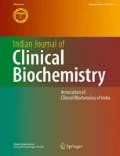Abstract
The serum acid phosphatase (ACP) activity and Hemoglobin (Hb) levels were measured in malaria patients and nonmalarial fever patients. The results were compared with normal healthy control subjects. ACP was significantly increased (P < 0.001) in all the malaria patients. ACP was significantly higher in Plasmodium falcifarum malaria and mixed malaria when compared to Plasmodium vivax malaria. Hb levels were significantly decreased in all the malaria patients which indicates that malaria parasite uses host erythrocyte Hb as a major nutrient source. There is negative correlation(r = −0.478) between ACP and Hb in malaria patients, which is highly significant. These results suggest that the measurement of ACP could be used as a marker for malaria.
Similar content being viewed by others
References
George YS, Lois MJ, Hary LR. Th estimation of serum inorganic phosphate in acid and alkaline phosphatase activity. J Biol Chem. 1942;142:921–33.
Dissing J. Immunochemical characterization of human red cell acid phosphatase isoenzymes. Biochem Genet. 1987;25:11–2.
Vasudevan DM, Sreekumari S. Text book of biochemistry. 3rd ed ed. New Delhi: Jaypee Brothers Medical Publishers (P) Limited; 2001. p. 50–2.
Palmarino R, Agostino R, Zgloria F, Lucarelli P, Businco L, Antognoni G, Maggioni G, Workman PL, Bottini E. Red cell acid phosphatase: another polymorphism correlated with malaria. Am J Phys Anthrpol. 2005;43(2):177–85.
White NJ. The pathophysiology of malaria. Adv Parasitol. 1992;31:34–173.
Bruce-Chwatt LJ. History of malaria from prehistory to eradication. Malaria, principles and practices of malariology. Edinburgh: Churchill Livingstone; 1988. p. 1–59.
Bergmeyer HV. Methods of enzymatic analysis. Weinheiam: Verlag Chemie; 1984. p. 92.
Varley H. Practical Clinical Biochemistry. 5th ed. In: Determination of serum acid phosphatase. London: William Heinemann Medical Books Ltd; 1980. p 913–915.
Anderson HR, Nielsen JB, Nielsen F, Philippe G. Antioxidative enzyme activities in human erythrocytes. Clin Chem. 1997;43(4):562–8.
Gupta CM. Red cell membrane alterations in malaria. Ind J Biochem Biophys. 1988;25:20–4.
Prassannachandra, D’Souza V, D’Souza B. Comparative study on lipid peroxidation and antioxidants vitamins E & C in falciparum and vivax malaria. Ind J Clin Biochem. 2006;21(2):103–6.
Goldberg DE, Slater AF, Cerani A, Henderson GB. Hemoglobin degradation in malaria parasite Plasmodium falciparum: an ordered process in a unique organelle. Proc Natl Acad Sci. 1990;87(8):2931–5.
Kremsner PG, Greve B, Lell B, Luckner D, Schmid D. Malarial anemia in African children associated with high oxygen radical production. Lancet. 2000;355:40–1.
Bhabhani SD, Nilini KN. Evidence for erythrocyte lipid peroxidation in acute falciparum malaria. Trans R Soc Trop Med Hyg. 1999;93:58–62.
Clark IA, Hunt NH. Evidence for reactive oxygen intermediates causing the hemolysis and parasite death in malaria. Infect Immun. 1983;39:1–6.
D’Souza B, D’Souza V, Swagatha H, Vijayalaxmi K, Namratha AS. Erythrocyte superoxide dismutase and catalase and their correlation with malondialdehyde in falciparum and vivax malaria. Biomed Res. 2009;20(1):25–7.
Garba IH, Gatsing D, Uborn G. Elevated total and isoenzyme forms of acid phosphatase in falciparum malaria. Comput Rendus Biol. 2006;329(2):75–8.
Author information
Authors and Affiliations
Corresponding author
Electronic supplementary material
Rights and permissions
About this article
Cite this article
D’Souza, B., Parthasarathy, R., Sreekantha et al. Acid Phosphatase as a Marker in Malaria. Ind J Clin Biochem 26, 396–399 (2011). https://doi.org/10.1007/s12291-011-0137-z
Received:
Accepted:
Published:
Issue Date:
DOI: https://doi.org/10.1007/s12291-011-0137-z



